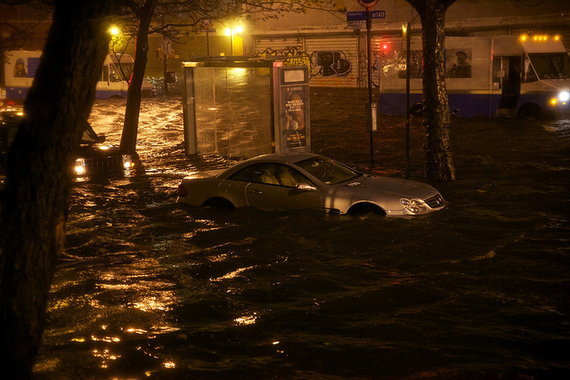Two years ago this week, Hurricane Sandy came barreling up the East Coast, killing 117 Americans and damaging hundreds of thousands of homes along the way. Here in my hometown of New York, it delivered an 11-foot storm surge and a reminder that climate change wasn't just a challenge for the future. On this anniversary, we honor those who lost their lives to the storm. And we acknowledge the thousands of survivors who suffered losses from the storm and who have yet to be made whole.
The storm waters have long since receded, but Sandy left an indelible mark. It made climate resiliency a priority in our region.
Many residents now recognize that climate change makes us more vulnerable to higher storm surges, frequent flooding and other extreme events. We have to brace for this new reality, and fortunately, we have begun.

Avenue C and 14th Street during Hurricane Sandy. Photo credit: Matthew Kraus
From reinforcing beaches in the Rockaways to installing generators at the Coney Island Houses and sealing holes in the subway system, New York is fortifying our ability to withstand future storm surges.
Yet much more remains to be done. Dozens of sound recommendations in Governor Cuomo's 2100 Commission Report and New York City's Special Initiative for Rebuilding and Resilience Report must still be completed. And even as we make our neighborhoods stronger, we must also confront climate change at its source: pollution from fossil fuels.
There is no single fix that can make our region more resilient in the face of climate change. But by working in our communities and at the national level, we can defuse this threat. Here are six areas where additional attention is greatly warranted.
1. Use Natural Barriers to Protect Our Coasts
Natural systems like wetlands, dunes and oyster reefs form a powerful first line of defense against coastal storms and regional flooding. Officials are recognizing the wisdom of adding soft edges to our coastlines: the projects chosen in the federal government's Rebuild by Design initiative will add natural protections in the waters off Staten Island's south shore, plant large new oyster reefs in New York Harbor and safeguard the South Bronx shoreline. Such projects need additional funding and political support to ensure they are completed.
2. Offer Floodplain Buyouts to Relocate Residents to Safer Grounds-
Buyout programs deliver three important benefits. Homeowners get paid fair-market value to move out of harm's way. Neighborhoods gain green spaces that serve as natural sponges for storm water. And the community saves money by reducing the need to repeatedly rebuild after each destructive storm. Governor Cuomo advanced floodplain buyouts in three Staten Island communities, and property owners in nearby communities are calling for additional buyouts. New York should expand these programs and make buyouts a permanent part of the state's resiliency arsenal.
3. Expand the Region's Green Infrastructure
Green roofs, roadside plantings, porous pavement, and sidewalk gardens have been proven to reduce flooding. They absorb rainwater before it swamps the streets and sewage systems. They also add green space to neighborhoods and enhance property values. New York City just announced it is building 2000 sidewalk gardens to aid in storm water capture. And New York State has taken steps to fund green infrastructure projects. Yet officials could do so much more--from using State Revolving Funds for large-scale green projects in flood zones to strengthening storm water management standards.
4. Update Floodplain Mapping
The Federal Emergency Management Agency floodplain maps are vital to protecting the public from future climate related storm surges. A recent NRDC analysis showed that 290,000 New Yorkers were inundated by Sandy floodwaters even though their properties were not included on FEMA's 100 year floodplain map. New FEMA maps produced after Sandy more accurately illustrate New York City's flood risk, but still fail to account for future risk from sea level rise.
5. Reform Federal Flood Insurance Program
One area still in need of major reform is the National Flood Insurance Program. Sandy showed how inadequate it is in the face of climate change. Currently the program gives generous discounts to some floodplain property owners, making it hard for people to grasp the risks they face -- and catching them by surprise when flood strikes. The program must be updated to make insurance prices reflect the risk and cost of flooding. This can be done while still providing a safety net for those in need -- including expanded buyout programs, longer transition periods for properties newly identified within flood zones and assistance to low- and middle-income homeowners.
6. Reduce Climate Change Pollution
Our area has already started reducing the pollution that causes climate change. New York and Connecticut belong to the Regional Greenhouse Gas Initiative to cut carbon emissions and New York City has been a leader in energy efficiency. But we can do more to tap our area's clean energy resources. And we can help tackle pollution at the national level. In June, the EPA proposed the first national limits on carbon from power plants -- the largest source of these dangerous emissions in the US. Click here to tell the Obama Administration you support strong limits on carbon pollution.
